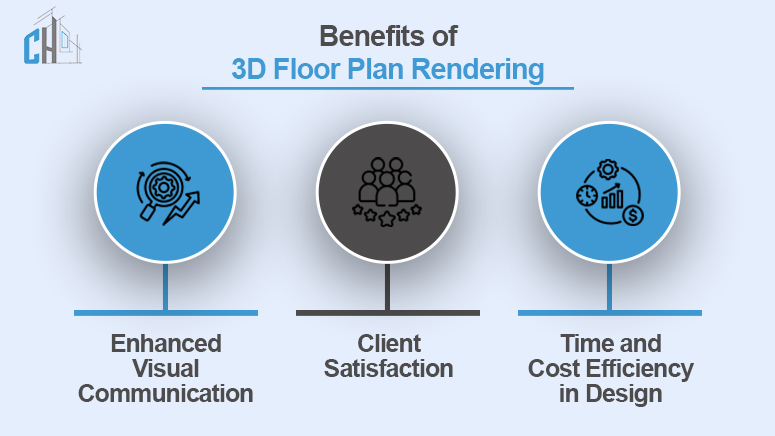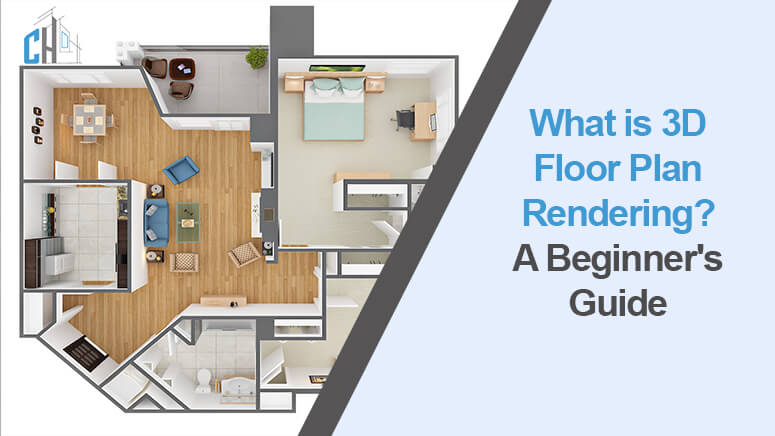Quick Summary: Imagine being able to walk through a space before it’s even built. That’s the magic of 3D floor plan rendering. This great tool is used to convert architectural drawings directly into three-dimensional models. It is not just about aesthetics but about creating physical manifestation and clarity of ideas for all the stakeholders.
Over the course of recent years, 3D floor plan rendering has grown to become even more sophisticated, revolutionizing the fields of architecture and design. This technology is important to know for architects, interior designers, and agents specializing in real estate.
In this guide, everything concerning 3D floor plan rendering is covered, such as what it is, why it is important, how it is done, and the future of 3D floor plan rendering.
Benefits of 3D Floor Plan Rendering
There are many benefits to using 3D floor plan rendering services in your design projects. In this section, we will discuss the key advantages of incorporating 3D floor plans into your designs.

Enhanced Visual Communication
While a picture speaks a thousand words, a 3D rendering could be even more precious. In so doing, the architects and designers bring realistic and tangible graphic representations of their ideas and plans into reality. Clients and stakeholders can examine spaces from different perspectives, including a bird’s view and useful information about the size, traffic patterns, and beauty.
With this, there is a minimized misunderstanding, and with the increased advancement in technology, the overall picture is so clear to draw even a layman. Solutions can be thought and implemented before the start of the construction process, which makes the process faster and more cost-effective. To the real estate agents, presenting the tiny home in 3D floor plan renderings makes the offering more appealing to potential customers and grabs their attention better.
Client Satisfaction
Architects’ clients do not understand statics such as blueprints and sketches most of the time. 3D floor plan rendering helps overcome this challenge. It makes clients understand the design work better by creating a perception of what their spaces will look like in the future. This results in improved decision-making, increased participation of the workers in the project undertaking, and, therefore, increased satisfaction.
With 3D rendering, clients are able to simulate different layouts and materials, which may be difficult or costly to explore. This way, seeing those choices in a realistic setting, the final achievement will fulfill those expectations they have. Thus, such a kind of collaboration enhances the interdependence between the client and designer, which contributes to the development of considerable trust in their cooperation.
Time and Cost Efficiency in Design and Construction Phases
The differences in efficiency introduced by 3D floor plan rendering are striking. In the design phase, alterations can be made easily and efficiently, with no need to use physical models or produce several changes. It is for this reason that there is flexibility, hence ensuring that there is a minimum time taken to complete a project.
Construction benefits too. Discoverable concerns can be established so that such problems can be resolved at an early stage due to comprehensive visual discussions. The focalized model also reduces the overall time required to complete tasks and the risk associated with generating errors. Due to the visual guide for builders, the usage of 3D renderings is helpful in achieving more efficient outcomes at construction sites.
The Process of Creating 3D Floor Plans
Creating 3D floor plans can be a complex process that requires attention to detail and technical expertise. While there is no single right way to create a 3D floor plan, there are some general steps that can help guide the process.
Gathering Necessary Information and Materials
Realistically, the process of creating a 3D floor plan starts with the collection of imperative data. Dimensional accuracy and scale, blueprints and layouts, and design surmises are all important. Other information about the materials, furniture, and decorations should also be incorporated to reflect the correct picture of the project as conceptualized.
Clients, architects, and designers are involved in this phase and have to cooperate effectively. This way, there is no confusion between experts and clients about what is expected of a 3D rendering and whether it will fit the needs of all the involved parties.
Using of Specialized Software and Tools
After the information is gather, the designers will use software to make the 3D floor plan. Programs like Auto CAD, Sketch, and Revit enable designers to create these models with a very high level of detail. The software has numerous features in this regard, such as viewpoint- and object-related lighting effects, realistic textures, and interactive navigation systems.
They can try to adjust the position of the wall, the size and positioning of the window, and even the positioning of the furniture to yield the required results. This leads to a fully rounded and aesthetically impressive overview of the project.
Options for Customisation & Detailing
Furthermore, the flexibility of varying the aspects of the 3D floor plan rendering is another advantage. It allows designers to adjust every element of a model and match it to specific characteristics of the project. Starting from the choice of color for painting and right up to the selection of floor finishes, the opportunities are limitless.
It thus requires a degree of fine detail that cannot be ignore in any project of immense size. Such things like plants, pieces of art, and many other items are great for making the environment feel more alive. These crucial touches improve reality and allow clients to see what their dwelling or working space will be like.
Challenges and Future Trends
There are several challenges that researchers and developers face in the field of AI. One of the main challenges is the lack of data privacy and security. As AI algorithms become more advanced and powerful, there is a growing concern about how personal information is being collected, stored, and used.
Frequent Challenges in 3D Floor Plan Rendering
There is nothing that is easy with everything that has to do with architecture, including 3D floor plan rendering, as much as it may be advantageous. One typical challenge that learners face is the process of adapting to the use of software that has specialized functions. Designers are also require to spend a lot of time training to understand these sophisticated tools.
The third concern is to address the issue of the client’s expectations. As for now, 3D renderings are used; they are realistic, and at the same time, they are just imagery, and therefore, they will not necessarily show all the details of a final built structure. It is therefore important that clients are very well made to understand this difference for clear communication.
New Technologies and Ideas in the Development of the World
As technology advances, the possibilities for 3D floor plan rendering become optimistic. The disciplines of VR and AR gradually intersect so that clients can further contemplate spaces interactively.
AI and machine learning are also expect to feature in them. These technologies can partially or fully control some rendering procedures and accelerate them. In addition, they can also present predictive design solutions generated through data analysis functions and user preferences.
Tips for Choosing a 3D Rendering Service
There are several factors to consider when choosing a 3D rendering service, which can greatly impact the quality and timeliness of your final product. Here are some tips to help you make an informed decision:
Factors to Consider When Selecting a Rendering Company
Selecting the right 3D rendering company is crucial for achieving the best results. Start by evaluating the company’s experience and expertise. Review their portfolio to assess the quality and style of their work. Look for companies that have experience with projects similar to yours.
Consider the range of services offered. Some companies provide additional features, such as VR walk-throughs or post-production editing. Ensure that the service aligns with your specific needs and budget.
Questions to Ask Potential Service Providers
Before committing to a rendering service, ask key questions to ensure a good fit. Inquire about their process, turnaround times, and pricing structure. Request references and read testimonials to gauge the experiences of past clients.
Clarify communication channels and how revisions are handle. A transparent and collaborative approach is essential for a successful partnership. By asking these questions, you’ll gain confidence in your choice and ensure a smooth collaboration.
Conclusion
In conclusion, it is possible to state that outsourcing 3D rendering services has become a relief for architects and interior designers, as well as for agents that deal with the sale of real estate properties. BIM enhancement towards design and build practices recommended communication and understanding of the client’s visual as well as the efficiency in building construction. As far as effectiveness at transforming shapeless thoughts into forms, it is quite beneficial for the world market today.
Looking at the future, there are equally enormous possibilities in 3D rendering. Other domains of flexibility are expected to be attained from as VR and AI in the future. It should, therefore, be the duty of the said professionals to constantly update themselves with conditions in the market and in equal measure look for more opportunities to employ 3D rendering for better performance.
Anyone intending to apply this technology in their projects begins by selecting the appropriate 3D rendering service. Consequently, people involved in the decision-making process regarding security service providers have prior experience in the services the given company provides and interaction. Looking to create sublime and powerful 3D floor plans? All one needs is a good partner for it.





